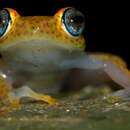Description
provided by AmphibiaWeb articles
M 21-23 mm, F 32 mm. Tibiotarsal articulation reaches at least the nostril and often beyond snout tip. Hand with some webbing, foot webbing 1(0), 2i(0.5), 2e(0), 3i(1.25), 3e(0.5), 4i/e(2), 5(0.5). Dorsal skin smooth. Dorsally green, sometimes with traces of yellow dorsolateral lines, and always with numerous, evenly spaced small red dots. Tips of fingers and toes greenish. Outer iris area turquoise, iris periphery blue (Glaw and Vences 2007). Similar species: B. erythrodactylus differs by having red colour on the tips of fingers and toes (Glaw and Vences 2007).Taken partly from Glaw and Vences (2007), with permission.
Vences, M., Glaw, F., and Nussbaum, R. (2008). Boophis tasymena. In: IUCN 2008. 2008 IUCN Red List of Threatened Species. www.iucnredlist.org. Downloaded on 24 March 2009.
- author
- Miguel Vences
- author
- Frank Glaw
Distribution and Habitat
provided by AmphibiaWeb articles
An’Ala, Andasibe, Mananara, Mantadia, Ranomafana (Vohiparara, Imaloka, Maharira forest) (Glaw and Vences 2007). It occurs at 300-900 m asl in pristine rainforest (Vences et al. 2008).
- author
- Miguel Vences
- author
- Frank Glaw
Life History, Abundance, Activity, and Special Behaviors
provided by AmphibiaWeb articles
Males call at night from 1-3 m above the ground in the vegetation next to streams in rainforest. The call is a short, high-pitched note consisting of two, sometimes three, clicks (Glaw and Vences 2007). Breeding occurs in the streams (Vences et al. 2008)
- author
- Miguel Vences
- author
- Frank Glaw
Life History, Abundance, Activity, and Special Behaviors
provided by AmphibiaWeb articles
A common, widely distributed species, but threatened by habitat loss due to increasing subsistence agriculture, logging, charcoal manufacture, invasion and spread of eucalyptus, increased grazing and expanding human settlement. Requires pristine forest. Occurs in several protected areas (Vences et al. 2008).
- author
- Miguel Vences
- author
- Frank Glaw
Boophis tasymena: Brief Summary
provided by wikipedia EN
Boophis tasymena is a species of frogs in the family Mantellidae endemic to Madagascar.
Its natural habitats are subtropical or tropical moist lowland forests and rivers. It is threatened by habitat loss.
- license
- cc-by-sa-3.0
- copyright
- Wikipedia authors and editors

